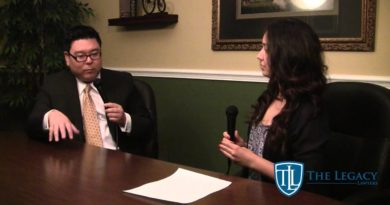Estate Planning for Seniors with Large Portfolios
28 February Estate planning in your sixties: A senior’s guide
For seniors with large financial portfolios like you, you’ll have to take some steps to protect the wealth you’ve worked so hard to earn. A well-planned estate will not only help your heirs avoid extraneous costs such as probate fees and taxes, but it will also ensure a smooth transfer of assets after your death. Let’s go over some of the basic steps you can take to protect your assets when you have a large portfolio.
Estate Planning for Large Portfolios
In general, the goal of estate planning is to protect high-value assets or those that are difficult to transfer. Set up a trust with your assets, such as real estate, business interests or investments, and fund it. Only certain assets, such as retirement accounts and life insurance policies, can be passed directly to their beneficiaries. Setting up a trust will help you keep your assets out of the probate process.
Step One: Create a Trust
How To: Trusts can be used as estate planning tools to manage and preserve your wealth both during your lifetime and after. A lawyer who specializes in estate planning can help you select the right trust type and draft the necessary legal documents.
These are several types of trusts, each with different advantages:
- With a revocable living trust you retain full control over the assets, and you can modify, revoke, or make changes to the trust at any time.
- An irrevocable trust offers benefits such as asset protection and tax savings. Once the trust is created, you cannot modify or dissolve it without the consent from the beneficiaries. You can also use this strategy to reduce your income taxes during your lifetime. You can also use this strategy to reduce your income taxes during your lifetime.Dynasty trusts
- are designed to last for multiple generations, allowing wealth to be passed down with minimal estate taxes.If you have beneficiaries with special needs, placing assets in a
- special needs trust ensures they can receive support without jeopardizing their eligibility for government assistance programs.Why trusts are important: Placing funds in a trust separates you from the money by removing it from your personal estate. The trust owns all assets because it is a separate legal entity. This can reduce the tax burden for your beneficiaries when you die. Trusts give you more control over the distribution of your assets, and they keep them out from probate. Step 2: Decide the Terms
- How do you do it? Make a decision on who is going to inherit your assets
and why. Also, decide how many people are included (or excluded), and when they should receive the inheritance. For instance, you might have several grandchildren that you would like to include as beneficiaries. However, each of them may require a different treatment. A grandchild with a successful career may benefit from a cash donation, while a grandchild in middle school might benefit from a college savings plan. Why is it important: Thoughtful preparation will protect your legacy. It is important to carefully select your beneficiaries and the conditions under which they will receive assets. It is important to carefully choose your beneficiaries and the terms around how they receive assets. Without careful consideration, your heirs may mismanage, misuse, or cause disputes. How to fund the trust:
Funding the trust involves legally transferring ownership to the trust.
Not all assets belong in a Trust. Retirement accounts, for example, should be kept out of trusts because they already have beneficiaries. Common types of assets people use to fund a trust are:
Real estate
Titled personal property like (boats, vehicles, and planes)Bank accounts
Business interests (shares in a corporation)
Investment accounts Why it’s important: This step protects your property in case you are ever unable to manage your estate. You will name
successor trust to manage your assets in case of disability or death. It is best to select a third party who has no interest in the estate, due to the importance of this task. Step 4: Make Charitable GiftsHow it’s done:
- To name a charity in your will or trust as a beneficiary, you must include the charity’s legal address and any other details about the gift. Details include the amount, percentage and purpose of your gift. You should also check with the charity if they accept donations. Consult an attorney to make sure the gift is legally valid and properly structured. Here are some ways to give.
- Annual gift exclusions
- You can give up $17,000 per person without gift tax in 2025. Consider giving appreciated assets like stocks to family members who are in lower tax brackets. This can reduce the taxable estate, and allow the recipient of your gift to benefit from lower capital gain taxes when they sell. You can contribute to 529 plans for your children and grandchildren to help them pay for their education. These contributions grow tax-deferred and are typically withdrawn tax-free if used for qualified education expenses.
- Charitable Donations
- : Donations to qualified charitable organizations can reduce your taxable income. Giving gifts as part of an estate plan can reduce your taxable estate. It allows you to pass wealth to your loved ones and charities near your heart while taking advantage of tax exemptions.
Step 5: Use Tax-Efficient Investment StrategiesHow to do it: Maximize contributions to tax-deferred accounts like 401(k)s and IRAs. These accounts allow your investments to grow without being taxed until withdrawal.Invest in tax-efficient assets. Municipal bonds are usually tax-free, and index funds (or exchange-traded funds), generate less
taxable events
than actively managed funds. If possible, hold onto your assets for longer than a year to benefit from the long-term capital gain tax rate which is usually lower than ordinary income taxes.
Why is it important?
- If your estate has more assets, you will have used tax-efficient strategies to invest during your senior years. Step 6: Create a Business succession planHow:
- For families businesses, a buy sell agreement
- will specify how shares will be transferred to heirs or sold to a 3rd party. Family Limited Partnerships can protect your business assets and offer tax benefits. They can also be a structured way for your heirs to get involved in the business. Step Seven: Optimize your tax-deferred or tax-free growth options
How you can do it:If you are eligible, contribute to a Roth IRA (or Roth 401(k)), where qualified withdrawals will be tax-free. This can reduce your future taxable earnings. Consider other tools, such as deferred annuities. While they’re not for everyone, a
deferred annuity
can help you grow your wealth tax-deferred and can provide a stable income stream in retirement.
- Why it’s important:
- You’ll end up paying less in taxes and preserving more of your wealth. Step Eight: Review Your Tax Situation RegularlyHow To Do It:
- Work With An Accountant or Tax Planner Who Specializes In High-Net-Worth Estates. Regularly reviewing your tax position can help you find opportunities to minimize taxes through strategic moves like shifting investments, utilizing tax credits, and rebalancing your portfolio.
Why it’s important: Estate plans should evolve. Tax laws, family dynamics and market conditions may change over time, requiring you to adjust your strategy. Review your plan periodically to ensure it is still aligned with you and your goals.
Get Personalized Advice from a Legal Professional
Given the complexity of managing a large portfolio and setting future generations up for success, it’s important to seek professional guidance. Phelps LaClair’s team is happy to guide you through the complexities of estate planning for a large portfolio. We will be with you and your loved ones every step of the way. We’re with you all the way. From drafting trusts, wills and other legal documents, to helping you create a comprehensive tax plan, to acting as your estate administrator, we are a firm that is there for you. Call our Arizona offices nearest you
for a consultation. Images used under creative commons
license
– commercial use (02.13.2025). Photo by pixabay
from picryl.com in the public domain.






